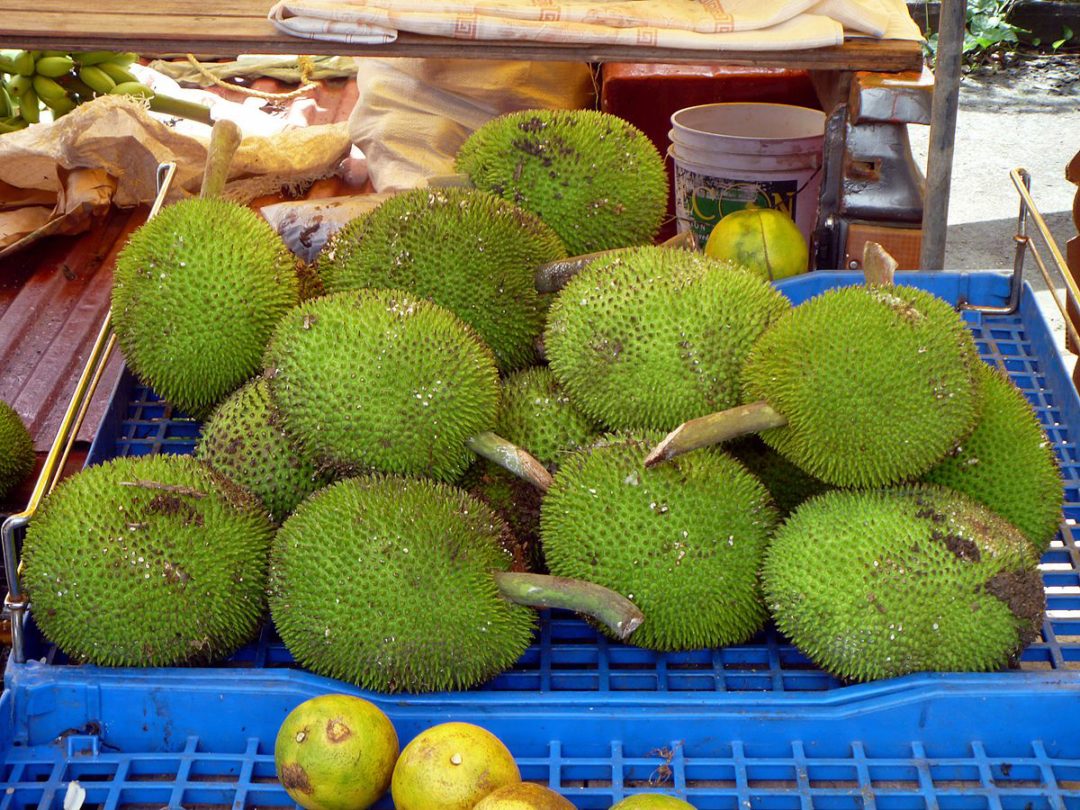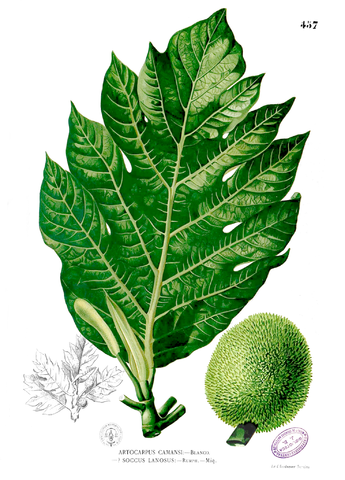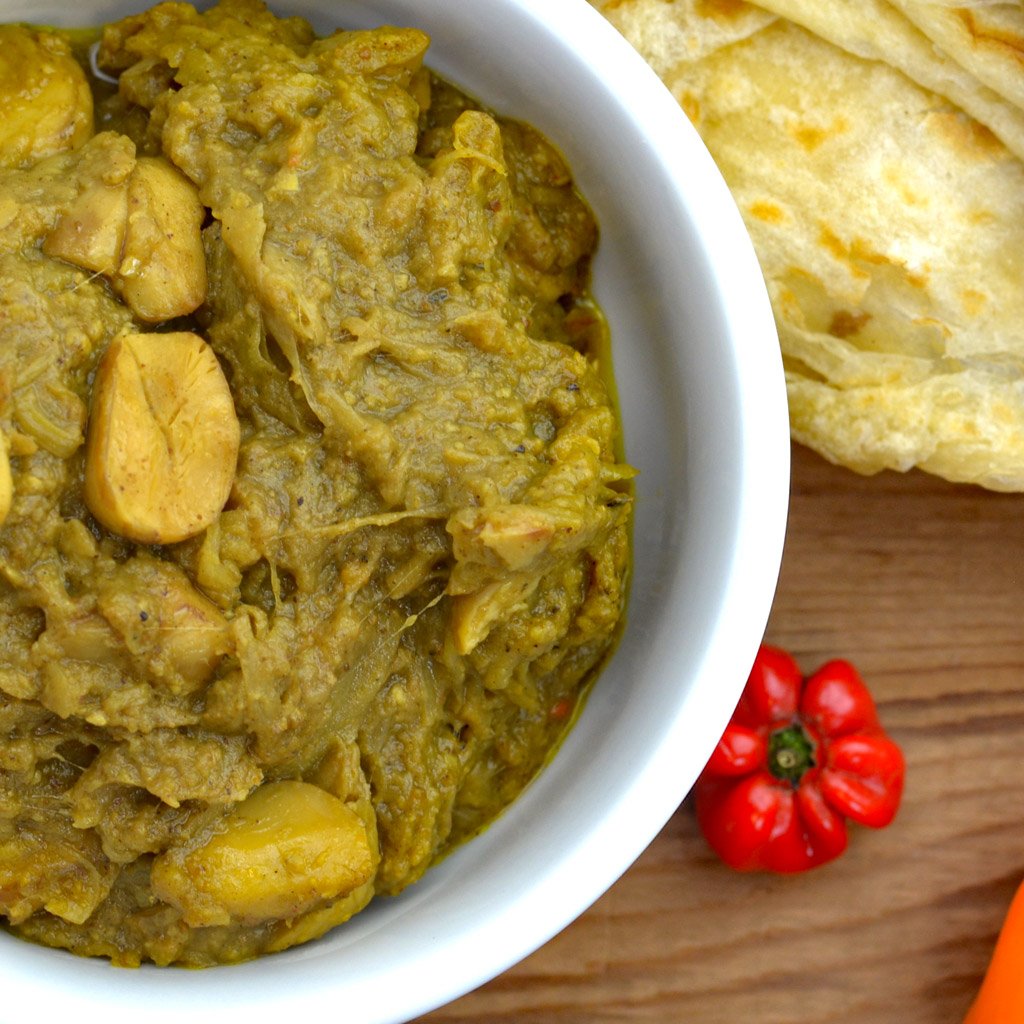The Insult
According to Neil Marks (Guyana Chronicle, 2016): “Katahar” is an Indo-Guyanese Creole word that carries the idea of nothingness. If someone were to tell you you’re a Katahar, they are really dismissing you as worth nothing. “Like you is a Katahar or wha?”.
Katahar – A Nut, Fruit or Vegetable

By Kalamazadkhan – Own work, CC BY-SA 3.0, https://commons.wikimedia.org/w/index.php?curid=20671403
Breadnut called Katahar in Guyana (Chataigne in Trinidad and Tobago) is, however, not to be dismissed as not worthless. In fact, it is a very tasty dish. Katahar Curry, is a key ingredient in a proper seven-curry – the dish mainly served at Guyanese Hindu religious events (Wedding Houses and Jhandies). The breadnut is a seeded variety of a breadfruit. Despite the name, it’s not a nut at

By Francisco Manuel Blanco (O.S.A.) – Flora de Filipinas […] Gran edicion […] [Atlas II].[1], Public Domain, https://commons.wikimedia.org/w/index.php?curid=6605454
Scientific Classification
Artocarpus camansi, the breadnut, is a medium-sized tree found in the mulberry family Moraceae. Native to New Guinea, the Maluku Islands, and the Philippines, it is a relative of the breadfruit and is commonly used as a staple crop. Other common names for plant include kluwih in Indonesia, chataigne, castaña ‘tropical’ (French and Spanish for the unrelated but culinarily similar chestnut”), and katahar in Guyana, pana de pepita in Puerto Rico, pan de fruta in Dominican Republic (Spanish for its relative breadfruit), kamansi in the Philippines, kapiak in New Guinea, and kos-del (කොස්දෙල් ) in Sri Lanka. It is also sometimes known as the seeded breadfruit, to distinguish it from its mostly seedless close relative Artocarpus altilis.
The species was first described in Flora de Filipinas. Según el sistema sexual de Linneo (1837) by the Spanish friar and botanist Francisco Manuel Blanco from specimens in the Philippines. The specific name is derived from Tagalog kamansi (Philippine Spanish: camansi), a local name for the tree in the islands.
Nutritional Value
Katahar is described as having “high nutritive value but it is an under-utilised food source”. Although not as commonly eaten as the breadfruit, it is an important crop in New Guinea, where the breadnut is a staple crop. Usually the fruit is consumed when it is immature; thinly sliced pieces are boiled in soups. In South Asia and the Caribbean it is curried and eaten. The seeds are also of economic value in the Caribbean, Central and South America because they taste like chestnuts. As a result, the seeds can be roasted, canned, or processed into paste, butter, flour or oil.
How to Cook Katahar
Cooking Katahar is a tedious but rewarding task. Cleaning and preparing the Katahar for cooking is a lengthy process that includes cutting, peeling and shredding the pulp, and shelling the nuts. Preparing the Katahar can take up to two hours. The cooking time can take up to an hour.
Ingredients
- 1 large green Katahar
- 2 large onions
- 1/2 head garlic
- 1 large hot pepper
- 1 tbsp ground garam massala
- 1 tsp ground geerah
- 2 tbsp curry powder
- 2 tbsp salt
- 1 tbsp vegetable oil
- 1/2-1 pt coconut milk
Method
- Wash Katahar, and cut into pieces. Peel and cut out core. Leave
Katahar and peel seed. Cut seeds into small pieces. - Wash Katahar meat and drain. Peel onions and garlic, wash with
the hot pepper, then chop and grind. - Make a massala paste with the onion mixture, garam massala, geerah,
curry powder and salt. - Heat oil in a large carahee. Add massala paste and Katahar seeds
and fry for 3-5 minutes. Add Katahar and fry for 3 minutes. - Cover and cook for 2 minutes. Add 1/2 pint coconut milk and stir.
Cook for 20 minutes. Add more coconut milk if it is too dry. Test
for flavor. - Cook until most of the liquid has evaporated. Serve with rice and
dhall.
Serves 12
Did you know?
Katahar curry is super delicious when cooked with shrimp or chicken.
The Seed/Nut Are Delicious When Boiled with Salt
Ripe Katahar seeds are delicious when boiled with salt. When the fruit becomes ripe it falls from the tree and the pulp becomes mushy. The seeds can easily be extracted, washed and set to boil.
Watch this CaribbeanPot.com Video to learn how to cook Katahar
References
- Main Image Source: https://orderfromalimas.ca/products/katahar-chataigne-1lb
- Wikipedia: https://en.wikipedia.org/wiki/Artocarpus_camansi







